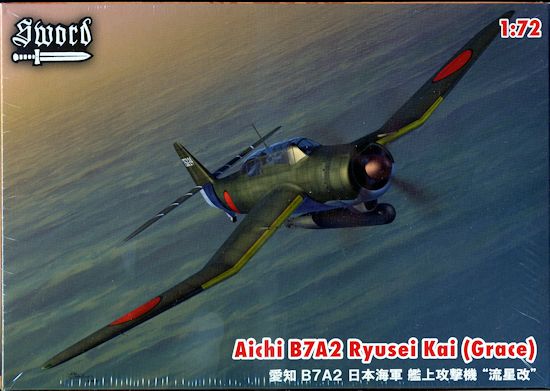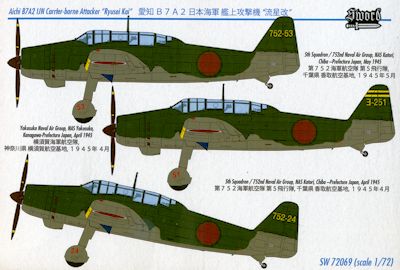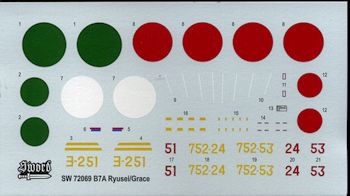
Sword 1/72 Aichi B7A2 'Grace'
| KIT #: | SW 72069 |
| PRICE: | $35.99 SRP |
| DECALS: | Three options |
| REVIEWER: | Scott Van Aken |
| NOTES: | New tool kit. |

| HISTORY |
The B7A Ryusei (originally designated AM-23 by Aichi) was designed in response to a 1941 16-Shi requirement issued by the Imperial Japanese Navy Air Service for a carrier attack bomber that would replace both the Nakajima B6N Tenzan torpedo plane and the Yokosuka D4Y Suisei dive bomber in IJN service. It was intended for use aboard a new generation of Taihō-class carriers, the first of which was laid down in July 1941. Because the deck elevators on the Taihōs had a larger square area than those of older Japanese carriers, the longstanding maximum limit of 11 m (36 ft) on carrier aircraft length could now be lifted.
Chief Engineer Norio Ozaki chose a mid-wing arrangement for the B7A to provide for an internal bomb-bay and to insure enough clearance for the plane's 3.5 m (11 ft) four-bladed propeller. This in turn necessitated the adoption of an inverted gull wing, reminiscent of the F4U Corsair, in order to shorten the length of the main landing gear. The wing featured extendable ailerons with a ten-degree range of deflection, enabling them to act as auxiliary flaps. Dive brakes were fitted underneath just outboard of the fuselage. The B7A's outer wing panels were designed to fold upwards hydraulically for carrier stowage, reducing its overall span from 14.4 m (47 ft) to approximately 7.9 m (26 ft).
Selection of a powerplant was dictated by the Japanese Navy which requested that Aichi design the aircraft around the 1,360 kW (1,825 hp) Nakajima NK9C Homare 12 18-cylinder two-row air-cooled radial engine. This was expected to become the Navy's standard aircraft engine in the 1,340 kW (1,800 hp) to 1,641 kW (2,200 hp) range. One production model B7A2 was later fitted with a 1,491 kW (2,000 hp) Nakajima Homare 23 radial engine and plans were also made to fit the 1,641 kW (2,200 hp) Mitsubishi MK9 radial to an advanced version of the Ryusei (designated B7A3 Ryusei Kai) but the latter effort never came to fruition.
The B7A had a weight-carrying capacity stemming from its requirements, resulting in a weapons load no greater than its predecessors. The presence of an internal bomb bay with two high-load-capability attachment points allowed the aircraft to carry two 250 kg (550 lb) or six 60 kg (132 lb) bombs. Alternatively, it could carry a single 800 kg (1,764 lb) torpedo mounted externally.
Defensive armament initially consisted of two 20mm Type 99 Model 2 cannons in the wing roots and one flexible 7.92mm Type 1 machine-gun mounted in the rear cockpit. Later production models of the B7A2 featured a 13mm Type 2 machine-gun in place of the 7.92mm gun.
Despite the plane's weight and size, it displayed fighter-like handling and performance, besting the version of the A6M Zero in service at the time. It was fast and highly maneuverable.
Given the codename "Grace" by the Allies, the B7A first flew as a prototype in May 1942, but teething problems with the experimental NK9C Homare engine and necessary modifications to the airframe meant that the type did not enter into production until two years later in May 1944. Nine prototype B7A1s were built and 80 production version B7A2s completed by Aichi before a severe earthquake in May 1945 destroyed the factory at Funakata where they were being assembled. A further 25 examples were produced at the 21st Naval Air Arsenal at Omura.
In June 1944, IJN Taihō, the only Imperial Japanese Navy aircraft carrier then large enough to operate the B7A Ryusei in its intended role, was sunk during the Battle of the Philippine Sea before enough B7As were even available to embark. Thereafter, the B7A was relegated to operating from land bases, primarily with the Yokosuka and 752nd Kokutais. The Japanese completed only one other carrier capable of operating the B7A, IJN Shinano, but she was sunk by an American submarine in November 1944, just ten days after being commissioned.
| THE KIT |
 After
doing a most welcome series of P-40s and T-28s, Sword has returned to doing
Japanese aircraft. This one is the rather large B7A, previously kitted by Fujimi
in the late 1980s. While the Fujimi kit is still a very nice one, this one has
much greater detail, especially in the cockpit and bomb bay.
After
doing a most welcome series of P-40s and T-28s, Sword has returned to doing
Japanese aircraft. This one is the rather large B7A, previously kitted by Fujimi
in the late 1980s. While the Fujimi kit is still a very nice one, this one has
much greater detail, especially in the cockpit and bomb bay.
Molded on two grey and one clear sprue, this Sword kit is minimalist in terms of resin. A small sprue contains wing cannon and the DF antenna. I did have one part broken in shipping and that was a prop blade, thanks to being on the end of the sprue. Obviously, the sprue engineer did not take into consideration that having the blades sticking out and unprotected would be easy targets for breakage.
The detail on the inside of the fuselage is superb with a bevy of control boxes and other various bits being very well represented. There are separate crew seats as well as other consoles and there is nicely raised detail on the instrument panel. The bomb aimer's position is equally well detailed with a nice sight and the mount for the rear gun along with the gun itself.
The kit provides options for an open or closed bomb bay. For the closed bomb bay, the builder needs to cut a piece from the open door option to fill in behind a clear viewing window for the bomb aimer. In this position, the weapon of choice would be the included torpedo. For the bay open option, the closed door section needs to be cut away to install the bomb crutch. Like the SB2C, this holds two bombs. In this option, the clear window will need to be cut in half to install in the open doors, which are folded on each side.
The engine is just the forward section which fits into the fuselage. The forward cowling is a complete piece so no nasty seam to deal with. Wheel wells are separate items that fit into the lower wing and the landing gear is nice and sturdy. There are separate lower exhaust stacks that will require a deft touch to install. Wing cannon are separate resin bits for this version. The canopy is in sections and I am guessing they are going to be a bit too thick to stack open as the instructions show them in the closed position.
 Instructions
are well drawn with colors provided by generic names so you are free to choose
your favorite brand of paints. The yellow leading edges of the wings will
require you to paint them on, which in my experience always provides a superior
look to things. All three markings options are Dark Green over Grey with Primer
Brown propellers and spinners. All three options have the
Instructions
are well drawn with colors provided by generic names so you are free to choose
your favorite brand of paints. The yellow leading edges of the wings will
require you to paint them on, which in my experience always provides a superior
look to things. All three markings options are Dark Green over Grey with Primer
Brown propellers and spinners. All three options have the
 fuselage
and upper wing roundels with a green outline as this was overpainted after
delivery. This is provided on the very nicely printed decal sheet. Two planes
were with the 752nd Naval Air Group in mid 1945 that differ only by aircraft
number. The other was with the very large Yokosuka Naval Air Group at the same
time. This one has two yellow stripes on the fin. Face it, Grace was not very
colorful as planes go.
fuselage
and upper wing roundels with a green outline as this was overpainted after
delivery. This is provided on the very nicely printed decal sheet. Two planes
were with the 752nd Naval Air Group in mid 1945 that differ only by aircraft
number. The other was with the very large Yokosuka Naval Air Group at the same
time. This one has two yellow stripes on the fin. Face it, Grace was not very
colorful as planes go.
| CONCLUSIONS |
This looks to be a very nice kit and is definitely superior to the Fujimi kit in terms of detail. It will take a bit more work than what you would use with the Fujimi offering, but the results will surely be worth it. I am betting we will see a B7A1 in the near future.
| REFERENCES |
http://en.wikipedia.org/wiki/Aichi_B7A
February 2013 Thanks to Squadron Products for the preview kit. Get
yours at your favorite retailer. If you would like your product reviewed fairly and quickly, please
contact
me or see other details in the
Note to
Contributors.